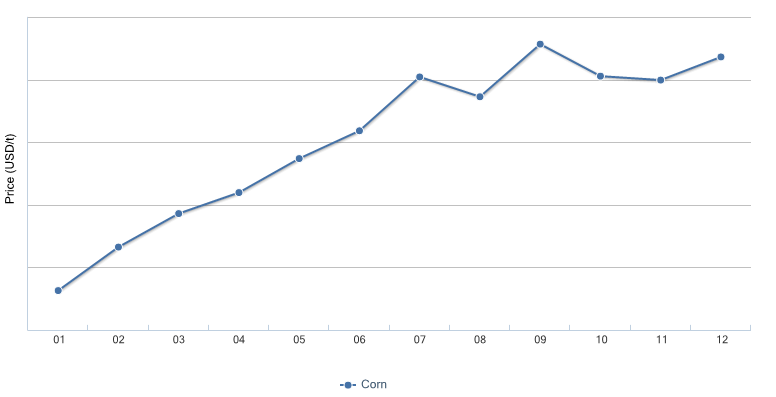China’s corn price
witnessed a stable trend in the harvesting season of 2017, due to less output
of corn, caused by extreme weather occurrences which damaged parts of the crop.
However, the price is likely to remain overall stable in the beginning of 2018,
despite the price hike in December, facing high supply and moderate demand.
Corn Price in China in 2017

Source: CCM
Market
intelligence firm CCM is of the opinion that the price hikes, which are
happening since the start of December in China, are just a psychological game
between corn sellers and buyers, without real substance to support the rise.
Looking
at the current corn market in Northeast China, the main region for corn
production in the country, most of the corn supply is held by small- and
medium-sized traders, which are able to store their corn in inventories, able
to keep the price high. In addition to that, as New Year's Day and Spring
Festival are coming in China, feed enterprises in the south of the country need
to purchase a lot of corn for animal feed, which creates a high demand that
furthermore boosts the prices of corn.
However,
as corn prices have raised a lot throughout 2017 already, Northeast companies
were cautious about purchasing corn in large amount. As a result, the corn
prices are unlikely to see high fluctuation in the beginning of 2018, remaining
stable in the short run.
In
the middle of December 2017, the Ministry of Agriculture revealed that China's
grain output stabilised at more than 6,000 kg in 2017, which represents a
bumper harvest again. It is predicted that grain corn areas in non-dominant
regions will be cut by about 1.33 million ha in 2017.
Price gap between
Chinese and global corn
China’s
corn stockpile and planting reforms, which indicate a reduced corn output and
planting area in China in the past year as well as in the coming years, have
resulted in a price gap between Chinese and world supplies, with a difference
higher than many investors have forecasted.
As
a result of the gap, China has increasingly become a net importer of corn, as
the domestic corn was not as competitive as the imports in terms of price. The
reasons for the uncompetitive price of domestic corn include rising costs of
farmland, labour, agricultural materials, small farm scale, less efficient
production and relatively low unit yield. As a result, a large portion of
rising domestic output of corn entered into the corn stockpile of the country.
Before
2010, China had been a significant net exporter, having exported as much as
15.2 million tonnes in 2002 at its peak. However, with export plunge in 2008
and low export volume since then and surging imports in 2010 and relatively big
import volume since then, China has become a net corn importer from 2010,
despite the fact that the rising domestic output has successfully limited the
extent of China's corn import and resulted in very high levels of
self-sufficiency rate of corn.
It
is forecasted that in the short run, direct government subsidies to producers
will be the major measures adopted by the Chinese government to facilitate the
difficult adjustments that need to take place as corn production and stock are
reduced. Only after these difficult adjustments have been completed, China can
adopt a less burdensome approach towards its intervention in the corn sector,
with features of lower government spending and lower levels of production, and possibly
a smaller gap between the domestic and the world market price.
CCM
considered that if the government aims to optimise corn stockpiles and to
balance the structure of supply and demand, it will set a rational purchase
price or even set a flexible price based on the market. In this way, storage
enterprises can purchase corn at the right price, which won't disturb the
healthy development of the market.
About this article
The
information of this article comes from CCM, China’s leading market intelligence
provider for the fields of agriculture, chemicals, and food & feed.
For
a detailed analysis of China’s corn market, please have a look at China’s monthly newsletter about corn products in China and
the recently published industrial market research reports.
For
any inquiries, please contact our team directly at econtact@cnchemicals.com or
call on 86-20-37616606.